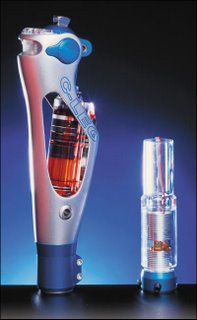
Advances such as telemedicine and the use of wireless devices in hospitals have become an accepted part of medical technology, but the notion of replacing limbs with computer-powered devices seems more like something out of "RoboCop" or "The $6 Million Man."
Since as far back as the Civil War, prosthetic limbs have consisted of unwieldy lumps of wood, plastic or metal. While some advances in materials have improved comfort for amputees, prosthetics still lack the responsiveness and feel of actual limbs.
Icelandic prosthetic maker Ossur is trying to change that with its Rheo Knee. Billed as the first knee with artificial intelligence, it combines up to 15 sensors, a processor, software and a memory chip to analyze the motion of the prosthetic and learn how to move accordingly. More recently, Ossur introduced the Power Knee, which houses a motor and more sensors. The motor helps replicate some of the action of muscles that have been lost along with the limb.
Save This Page
Medicine Tag
Health Tag
No comments:
Post a Comment